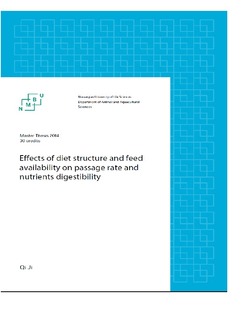| dc.description.abstract | The purpose of the experiment was to test the following hypotheses: birds have tendency for over-consumption of feed, and the extent of over-consumption varies through the day after a starvation period. Further, the hypothesis that a developed gizzard will prevent this problem was tested. The passage flow and digestibility in anterior tract was investigated in this study.
In trial 1, 48 Ross 308 male broiler chickens were fed ad libitum with two different diets. Diet 1 was a wheat-based diet with a few structural components and diet 2 was a wheat-barley-oat-based diet with structural components. At 19 days of age, birds were fed after 6 hours starvation, and then the excreta were collected shortly after feeding. At 20 days of age, after longer starvation period birds were fed ad libitum with diet 1 and 2 both in the form of pellets and mash, and then excreta were collected. At 21 days of age, after 10 hours starvation, birds were given access to feed and dissected every hour. Contents from the small intestinal and excreta were collected. Intestinal content was analyzed for starch and titanium oxide. In the results, starch digestibility was significantly higher (P <0.05) for birds fed diet with structural components than wheat-based diet. Starch digestibility varied through the day significantly caused by the underdevelopment gizzard. Moreover, no correlation was found between feed intake and starch digestibility.
In trial 2, 48 birds were randomly moved from ad libitum and intermittent feeding regime with feeding both experimental diet and commercial diet before. After 10 hours starvation, birds were fed with ad libitum and restricted. Birds were dissected after feeding 5 hours. All digestive tract content and excreta were collected for starch and titanium oxide analysis. The results from trial 2, there was no significant difference (P>0.05) on dry matter content and dry matter digestibility (P> 0.05) in each segments of small intestine. Furthermore, there was no correlation between feed intake and starch digestibility. | nb_NO |
